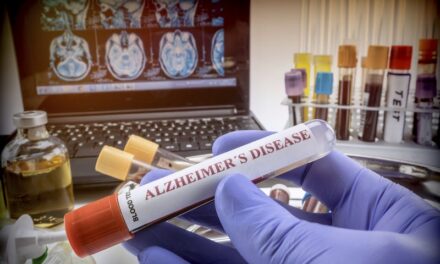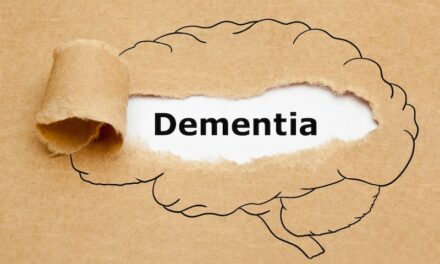It is estimated that one in 10 elderly Americans have Alzheimer’s Disease or another form of dementia. That number is expected to rise. A new test may aid in making Alzheimer’s disease a manageable condition.
By Chris Wolski
Alzheimer’s disease is devastating to both patients and their families and caregivers. And while there are better means to diagnosis Alzheimer’s today, in many cases, it is only determined after symptoms become apparent.
Today, about 6 million Americans are struggling with Alzheimer’s disease and other dementias. That number is expected to more than double by mid-century.1

In a wide-ranging discussion about the disease with CLP, Michael Racke, MD, medical director of neurology for Quest Diagnostics, outlines a new test that can help spot Alzheimer’s and other dementias earlier, what that means for treatment options, and how it could help transform Alzheimer’s into a manageable condition and not a death sentence for patients.
Racke’s responses have been edited for length and clarity.
CLP: Today, what is the typical way patients are diagnosed with Alzheimer’s or other dementia-related diseases? How are they limited?
Michael Racke: Testing for Alzheimer’s or other dementias comes in many forms. It can involve cognitive, cerebrospinal fluid, or blood tests, MRI, CT or PET brain imaging, neurological exams, or other assessments. However, patients are typically screened for Alzheimer’s disease only after signs of cognitive impairment emerge, and these methods are often very expensive. Also, traditionally only specialists can perform tests like brain imaging and cerebrospinal fluid taps, which can be uncomfortable and invasive.
CLP: Can you give me an overview of the less-invasive RestoreU Dementia Panel?
Racke: The RestoreU Dementia Panel is a risk assessment and care plan service to help physicians close care gaps for patients with cognitive decline. It uses artificial intelligence (AI) created and performed by uMETHOD to crunch lab data from tests performed by Quest and other medical history data specific to the patient. It can help a doctor identify if the patient has potentially reversible causes of cognitive decline, like medication side effects or hormonal imbalances, that mimic dementia. But importantly, it also helps identify measures to potentially slow or, if possible, halt dementia disease progression. A lot of people don’t realize that, while age and genetics greatly influence Alzheimer’s disease risk, there are measures that can be taken, from exercise to social engagement, to help reduce that risk. RestoreU provides guidance to help the patient understand what they can do specifically to hopefully reduce the risk.
CLP: It’s my understanding that the RestoreU Dementia Panel uses AI to help make diagnoses of Alzheimer’s disease and dementia. How important is the role of artificial intelligence in diagnosing disease? With some of the discussion around the potential dangers of advanced AI systems, are we taking the human decision-making process out of the hands of clinicians or is it improving diagnostic and clinical capabilities?
Racke: AI and automation are first and foremost for improving quality. At Quest, our advancements in automation are meant to improve the quality of results. Second, they can enhance the work our medical professionals are doing—not replace it. The healthcare industry is facing a decline in all sorts of medical professionals, from laboratory medtechs and histotechs to neurologists, pathologists, and primary care physicians. And these declines are happening as the population is aging, so the need for services will increase. Automated and AI technologies can help put more time back in the days of physicians, pathologists, and medical technologists, so they can focus on more meaningful tasks that will better patient lives. Ultimately, the act of diagnosis and crafting a treatment plan is still handled by a physician.
CLP: Are there any other methods being developed to diagnose Alzheimer’s and dementia that laboratorians should be aware of?
Racke: Blood tests hold incredible potential to aid assessment of Alzheimer’s. Last May, Quest launched the AD-Detect Amyloid Beta 42/40 Ratio, an analytically validated blood test that aids in assessing the risk of Alzheimer’s disease. The laboratory-developed test is designed to be used by a healthcare provider. It evaluates the ratio of two peptides of amyloid beta, Aβ42 and Aβ40, in plasma sourced from a single blood test and is designed to monitor Aβ42/40 changes over time to assess the risk potential of Alzheimer’s progression.
CLP: I read in Quest’s recent research report that one of the barriers to Alzheimer’s disease testing, like the ones we’re discussing here, could be reimbursement. Can you discuss briefly, the reimbursement environment generally for emerging tests?
Racke: Coverage for any laboratory service varies by health plan, plan type and other factors. Some, but not all, health plans are providing degrees of reimbursement for the AD-Detect 42/40 AB test under existing CPT coding. Without insurance, the patient list price is $650. However, Quest offers financial assistance programs designed to support access. In addition, we recently obtained a new billing code specific to the test—called a PLA code—and expect coverage and Medicare pricing determinations this year.
CLP: How do improved tests for Alzheimer’s disease and other dementia-related conditions help treatment? Even without a cure, how does improved and earlier screening methodologies help patient quality of life?
Racke: Actually, the idea you can’t do anything about Alzheimer’s is a misconception. First, we are now in an era where promising new pharmaceutical therapies truly hold potential to help reduce disease progression. Second, science now shows that people can reduce their risk of Alzheimer’s if they act in the early stages, ideally before symptoms occur. That’s why a couple of years ago, the U.S. Department of Health and Human Services added prevention as a goal to its nearly decade-old Alzheimer’s plan for the U.S. As better ways of identifying people at risk emerge, prevention will become increasingly important. That’s why Quest is so excited to offer blood tests that hold potential to aid assessment of risk in early stages.
In fact, in a survey we conducted of physicians, about 3 in 4 physicians (77%) expressed a belief that new therapies will transform Alzheimer’s disease into a chronic, manageable disease, and 84% say testing for early risk of the disease will lead to earlier and improved disease management. But even when there isn’t an option to slow or stop disease progression, there is value in a diagnosis. People can’t take action towards improving their health if they aren’t properly diagnosed and don’t know what to plan for or expect.
CLP: With better testing, what does the next 5 to 10 years look like for diagnosing Alzheimer’s disease and dementia? Will these tests be part of our regular battery of screening tests?
Racke: Our survey showed 9 in 10 (90%) U.S. adults are hopeful that new therapies will cure Alzheimer’s. While that may be ambitious, there is potential for Alzheimer’s to be a chronic but manageable disease in the not-too-distant future. Reducing disease progression is also critical. If you can stop progression in a person who is 80, 85, 90 years old, they may live a few good years and succumb to something else without experiencing the worst effects of Alzheimer’s. In my opinion, blood tests will be critical to fulfilling this potential. About 86% of people surveyed believe blood tests for the early detection of Alzheimer’s disease risk will increasingly become a regular part of preventative care, and we agree. Tests for amyloid, phosphorylated tau, neurofilament light chain, and other biomarkers will give physicians a better idea of where patients are in the Alzheimer’s continuum. Quality, accessible assessment gives patients the best chance at treatment, and it’s our hope that we can get to a place where everyone has access to these tests and ultimately better outcomes.
Chris Wolski is chief editor of CLP.
Reference
- “Quick Facts.” Alzheimer’s Association. 2023. https://www.alz.org/alzheimers-dementia/facts-figures#:~:text=More%20than%206%20million%20Americans%20of%20all%20ages%20have%20Alzheimer%27s,are%20age%2075%20or%20older.





